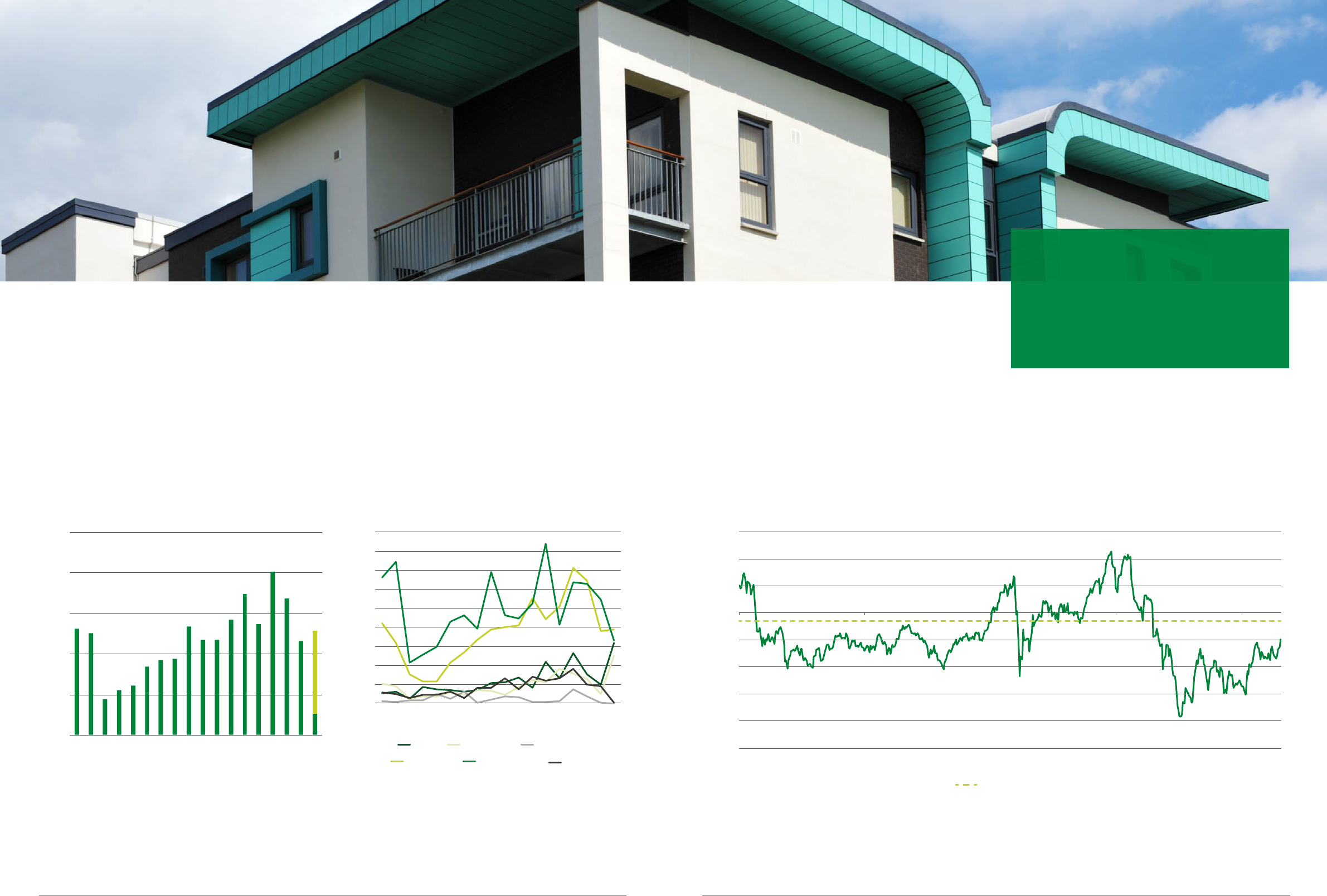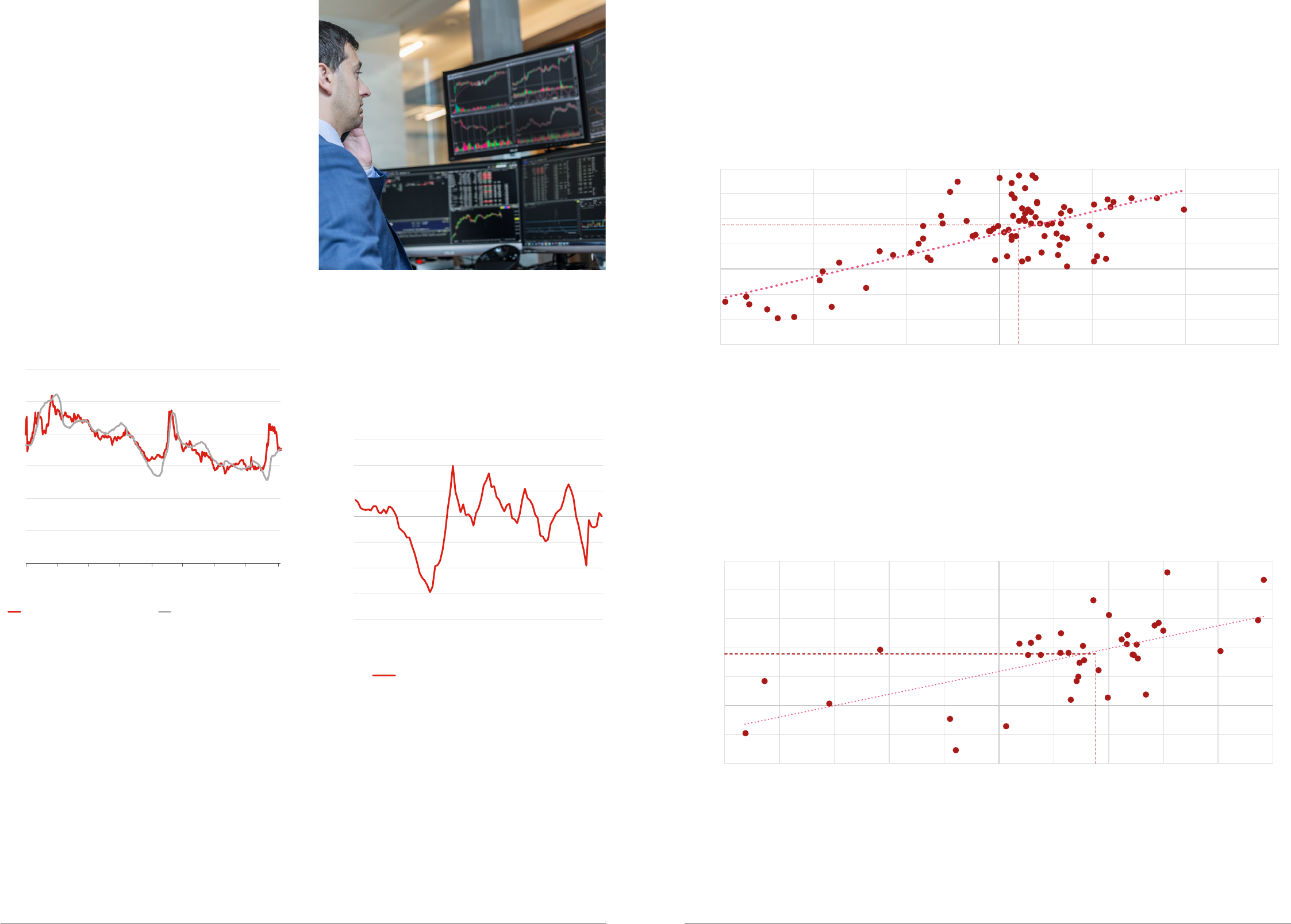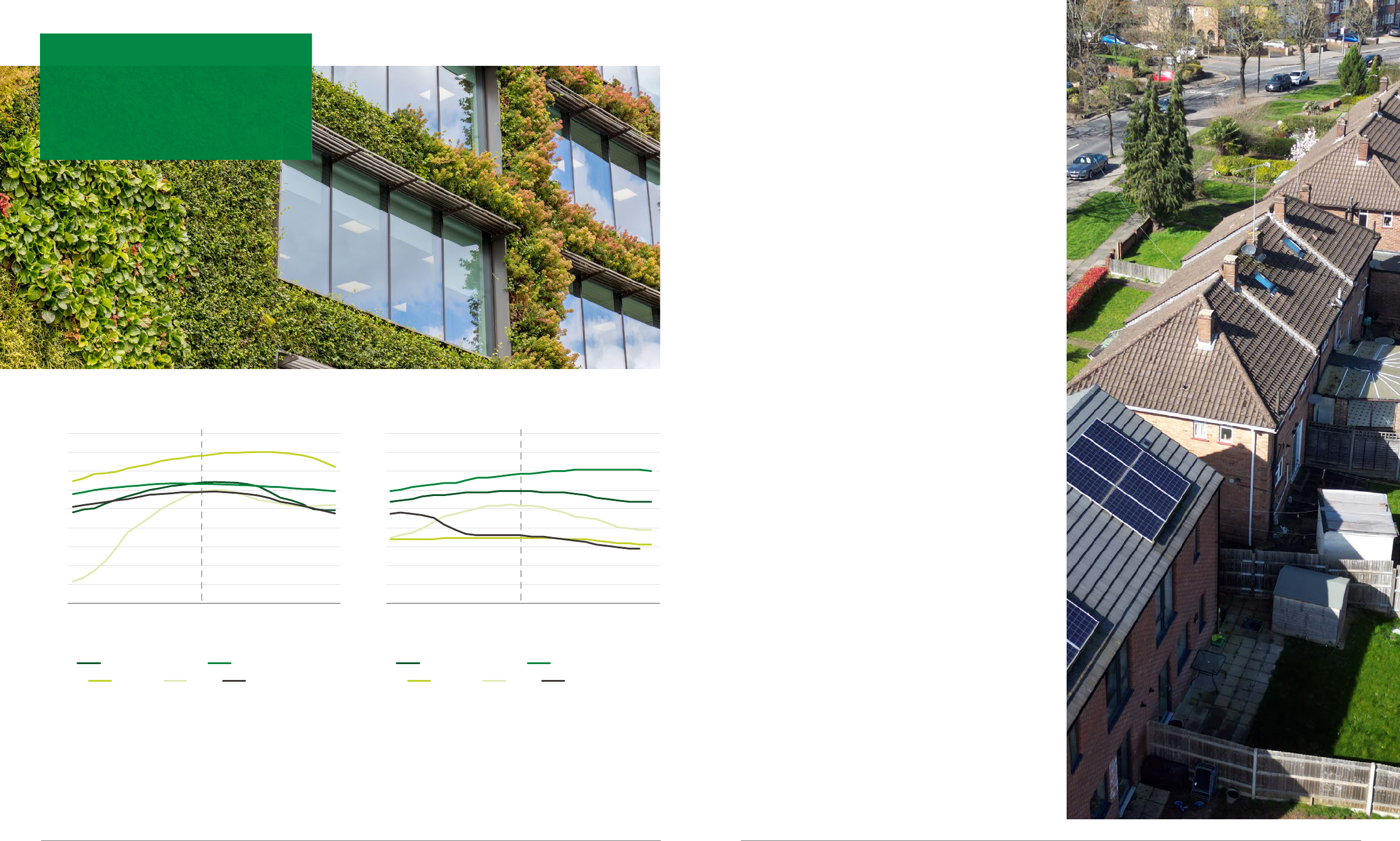
Real estate reset:
The case for UK
property
Executive summary
Bill Page
Head of Real Estate Research
1. After screening as expensive for several years, UK real
estate valuations now appear to offer fair value on a range
of metrics.
2. UK valuations also better reect current market pricing
than Europe and the US, in our view.
3. That said, sector and segment differentials remain
signicant and require careful navigation.
4. Continuing volatility in rates and potential geopolitical
risk suggest portfolios should still tilt to income resilience
rather than taking a binary ‘bet’ on yield compression.
In our view the latter should be seen as an upside risk
to expected returns, rather than a strategy.
2024
|
Real estate reset: The case for UK property
For professional clients only. Not to be
distributed to retail clients. Capital at risk.

3
2024
|
Real estate reset: The case for UK property
2
2024
|
Real estate reset: The case for UK property
Introduction
Since 2016, many asset classes, and UK real estate in
particular, have been rocked by a succession of events: Brexit,
Covid, spikes in ination, and a historically aggressive policy
rate hiking cycle.
At the midpoint of 2024, we feel the timing is right to look
objectively at pricing and valuation to establish a clear view
on the relative case for UK real estate.
Why now?
In our view UK real estate pricing – and indeed valuations –
have, after two years, reset to levels consistent with where
rates, and other macros drivers, have settled. Therefore, an
informed view on fair value and how pricing might evolve in
the medium term is warranted.
We do not, and should not, have condence in our ability to
forecast ination, interest rates or geopolitics. Although the
probability of a slow reduction in policy and market interest
rates between now and the end of 2025 is reasonably high,
it is not guaranteed. ‘Low probability, high impact’ geopolitical
events may yet impact markets. Such factors can inform
investment choices between resilient sectors and binary
yield plays.
We also reect that, internationally, gaps between transaction
pricing and valuation differ, and differences vary depending
on real estate sectors. Such differences matter for allocation
and deployment decisions.
According to higher frequency MSCI monthly data, UK real
estate values are approximately -25% lower than they were
in June 2022
1
. April 2024’s reading showed almost zero
movement in aggregate, with industrial and residential values
appreciating, retail stable, and oces falling
2
. This slowdown
does not guarantee the next move in values at the all-property
level will be upward, but it does make a discussion of relative
value timely.
Meanwhile, quarterly valuation data from MSCI clearly show
how the UK correction was harder and faster than other
regions.
1. Source: MSCI Monthly Digest, May 2024
2. Source: MSCI Monthly Digest, April 2024. Industrial and retail values were up 0.1% and 0.05% month on month respectively with oce values down -0.5%
Capital value change since June 2022, quarterly, global regions
Source: MSCI Global Quarterly Property Index, Q1 2024. Value changes re in local currency. Note the Europe excl UK is a LGIM Real Assets calculation based on available
data and reweighted. Past performance is not a guide to the future.
3. Source: IPF UK Real Estate Consensus Forecasts, Spring 2024
4. Source: ULI, Emerging Trends in Real Estate 2024
Other investors seem to agree that a change of fortunes is
imminent, with the IPF consensus
3
showing expected capital
growth of 0.8% this year and c. 3% p.a. between 2025 and 2028
inclusive.
At the same time, ULI
4
implies that global investors expect to
see more alignment on pricing and recovering volumes as we
move through 2024.
70
75
80
85
90
95
100
105
Jun
2022
Sep
2022
Dec
2022
Mar
2023
Jun
2023
Sep
2023
Dec
2023
Mar
2024
Europe Global U.S. UK Asia-Pacific Europe excl. UK estimate
In our view UK real estate
pricing – and indeed
valuations – have, after two
years, reset to levels
consistent with where rates,
and other macros drivers,
have settled.
Assumptions, opinions and estimates are provided for
illustrative purposes only. There is no guarantee that any
forecasts made will come to pass.

5
2024
|
Real estate reset: The case for UK property
4
2024
|
Real estate reset: The case for UK property
Global real estate fund raising, overall and by risk style, 2007 - 2024 (estimates)
UK REITS discount to net asset value
Source: Preqin, Data as at 31 March 2024. The light green bar is an estimate of fundraising over the remaining three quarters in 2024, based on average trends over
the last three years. Past performance is not a guide to the future. The value of an investment and any income taken from it is not
guaranteed and can go down as well as up, you may not get back the amount you originally invested. Assumptions, opinions
and estimates are provided for illustrative purposes only. There is no guarantee that any forecasts made will come to pass.
Source: Bloomberg, LGIM Real Assets, May 2024. Past performance is not a guide to the future. The value of an investment and any income
taken from it is not guaranteed and can go down as well as up, you may not get back the amount you originally invested.
Does UK real estate offer fair value?
The UK REIT sector currently trades at a -9.8% discount
to net asset value compared to a long-term average of -4.7%.
This compares favourably to its recent trough of -38%
6
. Asset
valuations (the NAV) have fallen to close the gap with investor
perceptions of pricing, which may have stabilised. Such
high-frequency signals were hugely important in gauging
valuation risks to direct UK real estate as markets evolved
over summer 2022; and they should not be ignored as
sentiment improves.
Global data from Preqin
5
shows how real estate fundraising
was affected by the macro picture in recent years. But more
interesting, we think, is the deviation in fundraising by style.
Two years ago, there was a surge in fundraising activity for
value-add styles. We would interpret this as fund managers
requiring greater risk to deliver investors the return over the
risk-free rate they require.
Furthermore, strategies that combine direct real estate and
indirect and more liquid REIT options have been shown to
outperform
7
. We think the recent performance seen in REITs is
indicative of an ability to capture growth before direct property
valuations do.
More recently, value-add strategies have decelerated from their
cyclical highs, replaced by an increase in core and core+
strategies. We think this shows managers are more
comfortable with current property pricing and see less need
to take additional risk.
5. Source: Preqin Quarterly Updates, May 2024
6. Source: Bloomberg, LGIM Real Assets calculations, May 2024
7. Source: See, for instance, “Blending Public and Private Real Estate Allocations for Dened Contribution Pension Funds: A U.K. Case Study”, Journal of Real Estate
Portfolio Management, Vol. 20, No. 3, 2014
0
50
100
150
200
250
2007
2008
2009
2010
2011
2012
2013
2014
2015
2016
2017
2018
2019
2020
2021
2023
2022
2024
Capital raised ($bn)
0
10
20
30
40
50
60
70
80
90
2007
2008
2009
2010
2012
2011
2013
2014
2016
2015
2017
2018
2019
2020
2021
2022
2023
2024
Capital raised ($bn)
Core Core-plus
Distressed
Value add Opportunistic
Other
The UK REIT sector currently
trades at a -9.8% discount to net
asset value compared to a long-
term average of -4.7%. This
compares favourably to its recent
trough of -38%.
-50.0
-40.0
-30.0
-20.0
-10.0
0.0
10.0
20.0
30.0
20162014 2018 2020 2022 2024
%
UK average

7
2024
|
Real estate reset: The case for UK property
6
2024
|
Real estate reset: The case for UK property
LGIM Real Assets has several proprietary models it can use to
gauge fair value and we cover two here. The rst is a yield
model which represents where valuation yields should be in
accordance with their historic relationship to rates, corporate
credit, lending activity and rental growth expectations. It
creates an expected yield and compares this to actual
valuation yields. This model showed a gap of 200 bps
immediately after 2022’s LDI crisis, implying signicant value
risk for directly held assets. These risks came to pass and,
following outward yield movement and some amelioration in
rate inputs, the yield model is now at parity with valuation
yields for the rst time in almost three years.
Secondly, LGIM Real Asset’s relative value indicator also looks
at MSCI yields and compares them to their own history and to
other asset classes such as equities and corporate bonds. This
indicator has screened ‘expensive’ since 2019, but – like the
yield model – has recently moved into neutral territory.
LGIM Real Assets yield model
LGIM Real Assets relative value indicator
Source: LGIM Real Assets, May 2024. Past performance is not a guide
to the future. The value of an investment and any income
taken from it is not guaranteed and can go down as well as
up, you may not get back the amount you originally invested.
Source: LGIM Real Assets, May 2024. Past performance is not a guide
to the future. The value of an investment and any income
taken from it is not guaranteed and can go down as well as
up, you may not get back the amount you originally invested.
Source: LGIM Real Assets, MSCI Quarterly Digest, Q1 2024. Past performance is not a guide to the future. The value of an investment and any
income taken from it is not guaranteed and can go down as well as up, you may not get back the amount you originally invested.
Source: LGIM Real Assets, MSCI Quarterly Digest, May 2024. Past performance is not a guide to the future. The value of an investment and any
income taken from it is not guaranteed and can go down as well as up, you may not get back the amount you originally invested.
Both models evidence our view that UK real estate offers fair
value – although we would emphasise that they do not suggest
the sector is cheap, only that it is no longer expensive. We
would also caveat this by pointing out it is the oce sector that
has done most of the recent work in increasing the all property
yield. Nevertheless, such signals have historically correlated
well with subsequent returns, as shown in the graph on the
next page.
LGIM’s relative value indicator and subsequent returns for UK all-property (three-year annualised)
Risk Premium and subsequent returns for UK all-property (three-year annualised)
Analysis of the risk premium offered by UK real estate (calculated by current yields plus growth expectations less depreciation and gilt
yields) currently shows a risk premium of 3.2%, compared to an average since 1981 of 2.6%. There is a notable range between sectors
on this measure, but the current all-property average is associated with subsequent returns in the region of 9-10% p.a., consistent
with the analysis above.
0%
2%
4%
6%
8%
10%
12%
1989
1994
1999
2003
2004
2009
2014
2019
2024
Predicted Equivalent Yield Actual Equivalent Yield
-2.0
-1.5
-1.0
-0.5
0.0
0.5
1.0
1.5
2000
2002
2004
2006
2008
2010
2012
2014
2016
2018
2020
2022
2024
Standard deviations
20 year indicator using equivalent yields
Not expensive
Expensive
-15
-10
-5
0
5
10
15
20
-1.5 -1.0 -0.5 0.00.5 1.
01.5
-
Subsequent 3 yr returns (% p.a.)
Relative value indicator score
Today’s relative value indicator
-10
-5
0
5
10
15
20
25
-10.0 -8.0 -6.0 -4.0 -2.0 0.0 2.0 4.0 6.0 8.0 1
0.0
Subsequent 3-yr returns (% p.a.)
Risk premium, year end
Today’s est. yield premium

9
2024
|
Real estate reset: The case for UK property
8
2024
|
Real estate reset: The case for UK property
Evolution of the risk-free rate
At the time of writing, nancial markets were pricing in two
policy rate cuts in the UK over the remainder of 2024 and three
by May 2025. Our expectations are very similar. Market interest
rates have adjusted to this slower anticipated pace of easing,
with 10-year gilts hovering around 4.2% and expected to reach
3.4% by year end 2025
8
. As mentioned above, analysts should
be humble in both their own predictions and in reading too
much into volatile nancial market signals.
But we can consider scenarios with relevance to the relative
pricing of real estate assets:
.
Rates fall, as implied
by markets
.
Rates fall faster than
markets imply
.
Rates stay at current levels
over the near term
.
Rates increase
We think that real estate yields, as evidenced by the
above metrics, have broadly adjusted to today’s
market interest rates.
Therefore, scenario 1 would allow for modest yield
compression as well as being consistent with a
reasonable economic backdrop supporting rental
growth.
Scenario 2, a faster reduction in rates, may all else
being equal technically allow for a reduction in real
estate yields, but could come at a recessionary cost
with weaker occupation markets.
Should rates stay at current levels – scenario 3 – then
our assumption that real estate values have already
broadly adjusted would suggest future returns are
almost entirely driven by income returns and rental
growth.
Finally, an increase in rates – scenario 4 – would
remove much of the potential for yield compression,
all else being equal, but may also be consistent with
stronger growth which could benet higher beta
sectors such as retail, as well as mitigating oce risk
via additional jobs growth.
Illustrative property equivalent yield in 2025 under various scenarios
Source: LGIM Real Assets, May 2024, based on MSCI Monthly Data as at April 2024 and calculated through LGIM’s yield model. Assumptions, opinions
and estimates are provided for illustrative purposes only. There is no guarantee that any forecasts made will come to pass.
In summary, there are various potential rates scenarios with only one of those considered – increased rates without any rental growth
benet –signicantly detrimental to real estate performance based off today’s valuation yields.
8. Source: Bloomberg as at May 2024
6.
4%
6.
6%
6.
8%
7.
0%
7.
2%
7.
4%
7.6%
Current yield Rates fall 50 bps Rates fall faster,
all else equal
Rates fall faster
and rental growth
flatlines
Rates rise further Rates rise further
and rental growth
improves
Assumptions, opinions and estimates are provided for
illustrative purposes only. There is no guarantee that
any forecasts made will come to pass.

11
2024
|
Real estate reset: The case for UK property
10
2024
|
Real estate reset: The case for UK property
Sector differences
The graphs below show the cumulative value change on the
MSCI monthly index by main sector, with an LGIM Real Assets
estimate for BTR (build-to-rent residential) where most of the
recent deterioration was a direct result of the scrapping of
multiple dwelling relief in this year’s budget). Yields are
commensurately different, with the expansion in oce yields
compared to other sectors historically aggressive.
Compared to an all-property valuation fall of -25% since June
2022, retail values have fallen -20%, industrial 27%
9
and oces
32% with the residential sample within MSCI down around 4%
and a BTR sample around -10%
10
.
Retail
Since values peaked in 2015, they have fallen in 23 of the
last 33 quarters, bottoming at -40% below 2015 peaks
(including events since 2022). Rental values are almost
-20% lower. This repositioning has led to the sector rising
up the ranks in many forecasts thanks to its strong
income returns (6.0%
12
) and growth potential, given its
more affordable rental base. We remain more cautious
than consensus, seeing continued risk to the consumer
in the near term, but do recognise opportunities at the
asset level where yields and rents have repriced and
where local demographics support long-term growth.
We feel the most compelling opportunities are in the
supermarket and retail park segments.
Leisure
Leisure now offers an income return of 6.7% from an
equivalent yield of 7.8%. The sector experienced a very
dicult Covid and, although we perceive consumer
expenditure shifting toward experiences from
discretionary purchasers as a long-term trend, the
cost-of-living crisis has also brought challenges.
Going forward, as these risks subside, income growth
on top of generous yields positions the sector well.
Industrial
More extensive views can be found in this paper, but in
short, we see industrial as a repriced sector offering
consistent growth potential for the long term, albeit with
notable segment differences which require careful
navigation. We prefer urban logistics and multi-let
industrials over, say, regional logistics, given different
supply and demand risks – although we think all
industrial segments could outperform the all-property
average over our forecasting horizon.
Residential
As with industrial, multiple segments with different
drivers offer a diversication of income styles within one
sector. We see most growth potential from BtR and
selective purpose-built student accommodation (PBSA),
with ination-linked income streams and the clear social
value upside offered by affordable housing. Despite
lower yields on average, we see the income growth
potential as signicant, potentially supporting
outperforming total returns both over our ve-year
horizon and on a long-term fundamental basis.
Oces
We offered more detailed thoughts in this series of blogs,
but in short we see MSCI valuations (reecting an average
of qualities) as near to fair value, given historic repricing,
but with higher quality oces much closer to this
threshold than lower quality oces, which in our view still
do not adequately compensate investors for known risks.
Although there could be some compelling income
streams on offer at generous yields, we still think it
unlikely that institutional investors will pivot towards the
sector while structural growth remains more convictional
in sectors like residential and industrial.
Other alternatives
We explain our approach to global megatrends in this
paper and this lens informs our long-term positioning in
various sectors within real estate and beyond. One eld
which straddles categories is digital infrastructure, in
particular data centres, where clear demand coincides
with a lack of appropriate built infrastructure.
Income styles: long income versus
operational
Yields available from long income investments with
ination linkage corrected sharply in 2022 and remain
generous relative to recent history. This could allow
institutional investors access to secure income streams
at higher yields than corporate equivalents.
At the other end of the risk spectrum, we are seeing more
operational styles in traditional segments like retail and
oces joining self-storage, hotels, student
accommodation and residential. Given the risks of
ination eroding operational income, caution on asset
and operator selection remains paramount here, but
where successful it can offer performance in real terms
and access to niche parts of the real estate market.
9. Source: -28% at their lowest (Feb 2023) but -27% at the end of April 2024
10. Source: MSCI Monthly Digest, April 2024
11. Source: BTR is our estimate of market build-to-rent residential capital value changes which were affected by the announcement
of the cessation of Multiple Dwellings Tax relief in the 2024 Spring Budget.
Capital value change (cumulative), peak to today, main MSCI sectors
Source: MSCI Monthly Digest, April 2024, LGIM Real Assets calculations
11
. Past performance is not a guide to the future. The value of an
investment and any income taken from it is not guaranteed and can go down as well as up, you may not get back the
amount you originally invested.
12. Source: MSCI Quarterly Digest, Q1 2024
-35
-30
-25
-20
-15
-10
-5
0
All prop Retail Office Industrial BTRMSCI Resi
%
Cumulative monthly, July ‘22
-
April ’24
Assumptions, opinions and estimates are provided for
illustrative purposes only. There is no guarantee that
any forecasts made will come to pass.
Assumptions, opinions and estimates are provided for illustrative purposes only.
There is no guarantee that any forecasts made will come to pass.

13
2024
|
Real estate reset: The case for UK property
12
2024
|
Real estate reset: The case for UK property
Valuations versus pricing: UK and international
By comparing valuation and transaction indices domestically
and internationally we can develop informed views on which
sectors are valued most eciently and which regional
investment destinations offer asset and fund valuations less
likely to be subject to further adjustment.
In the UK, a comparison of MSCI values and completed
transaction prices showed that, by the end of 2023, transaction
prices had moved by more than 7% compared to valuations
13
.
In the US, NCREIF has estimated oce cap rates at 6% and
pricing cap rates at 10.3%, with an average of 140 bps seen
across sectors
14
.
USA: Appraisal vs transaction cap rate, Q1 2024
Total forecast returns, 2024-2028
Source: NCREIF, LGIM Real Assets, May 2024. Past performance is not
a guide to the future. The value of an investment and any
income taken from it is not guaranteed and can go down as
well as up, you may not get back the amount you originally
invested.
Source: PMA Global Prime forecasts, Spring 2024. Assumptions, opinions and estimates are provided for illustrative purposes only.
There is no guarantee that any forecasts made will come to pass.
Industrial is a sector that has been more liquid than other
sectors and is therefore in our view more likely to see its
valuations match market pricing. We observe the widest
differential in the US, followed by Europe and then the UK,
where market pricing has now recovered ahead of valuations
15
.
It would seem, therefore, that the UK is further ahead in both
its return to fair value and in ecient pricing signals, although
we acknowledge persistent sector differentiation.
Forecasts and positioning
We expect UK real estate values to adjust -1% over this
calendar year
16
, led by oces, with a total return of around 5%
before modest yield compression and rental growth support
returns of around 7% p.a. between 2025 and 2028 inclusive.
This would equate to a full peak-to-trough value adjustment for
UK real estate of around 25%
17
with almost all of that now in
the past.
13. Source: MSCI transaction backed data. It is only available to the end of 2023 and hence misses further valuation adjustment which we expect
to bring valuations closer to market pricing. It also measures completed deals rather than bidding which can be slower to reect actual market adjustment
14. Source: NCREIF, May 2024
15. Source: Valuation data from MSCI, pricing data for Europe and US is from Green Street’s CPPI service. For UK it is JLL data, unweighted average for
Birmingham, Bristol, Edinburgh, Glasgow, Leeds, London, Manchester
16. Source: Based on MSCI’s UK Annual Digest
17. Source: Using the MSCI Quarterly Digest to reect intra-year movements
18. Source: PMA Global Prime forecasts, Spring 2024. Prime reects the change in estimated values for a high-quality well-located asset
This does, to some extent, rely on a managed path of interest
rate reductions but as we explored above, the market appears
well placed for most rate scenarios. The risk premium analysis
above is suggestive of upside risk to these forecasts, with
unlevered returns closer to 10%.
Forecasts for international performance show the UK is well
positioned, with PMA’s forecast of prime returns
18
showing
outperformance across global averages for all main sectors.
Although history is not guaranteed to repeat, analysis of
subsequent performance after previous downturns can also be
instructive. The graphs on the next page show returns on the
MSCI quarterly digest in the ve and 10 years after a cyclical
low point, assuming an investment is made in the period
immediately before or after a capital value trough. Given our
view that income curation and growth are the best ways to
navigate subsequent performance, with yield compression and
cyclical recovery more dicult to forecast and therefore best
seen as upside risks, we place lower weight on this analysis.
This is, however, illustrative of potential returns – before the
addition of leverage. It also shows that timing the trough of the
market precisely, very dicult in practice, does not make a
signicant difference to subsequent returns.
4.7
6
5.5
3.8
4.3
6.1
10.3
7.2
5
5.2
0
2
4
6
8
10
12
All property
Office
Retail
Industrial
Multifamily
Cap rate (%)
Appraisal cap rate Transaction cap rate
Industrial pricing and valuation around the world
(as at year-end 2023)
Source: MSCI, Green Street, JLL, LGIM Real Assets calculations.
Past performance is not a guide to the future. The value
of an investment and any income taken from it is not
guaranteed and can go down as well as up, you may
not get back the amount you originally invested.
MSCI peak to December 2023
Market pricing peak to today
MSCI Peak to December 2023 Market pr icing pe ak to today
-3
0%
-2
5%
-2
0%
-1
5%
-1
0%
-5%
0%
UK Europe US
0
1
2
3
4
5
6
7
8
9
Multifamily Retail Logistic
sO
ffice
%
Global average UK
0
50
100
150
200
250
2007
2009
2011
2013
2015
2017
2019
2021
2023
Capital raised ($bn)
Assumptions, opinions and estimates are provided for illustrative purposes only.
There is no guarantee that any forecasts made will come to pass.

15
2024
|
Real estate reset: The case for UK property
14
2024
|
Real estate reset: The case for UK property
UK all-property returns, unlevered, in the ve and 10 years after a capital value trough
19
Source: MSCI Quarterly Digest, Q1 2024, LGIM Real Assets calculations. Past performance is not a guide to the future. The value of an investment
and any income taken from it is not guaranteed and can go down as well as up, you may not get back the amount you originally
invested.
Conclusion
Analysis suggests the UK is well placed both domestically
and relative to international peers in terms of fair value, sector
relativities and growth potential. Equivalent yields in excess
of 7% with net operating income yields at 5.0% compare
favourably to other asset classes, with UK equities for example
yielding 3.8%
20
.
Real estate assets can provide investors with an income
stream they can potentially access at a cyclically cheaper entry
point that can be managed in an environmentally sustainable
way and can offer social benets.
Volatility in rates and potential shocks suggest portfolios tilt to
income resilience rather than binary yield compression plays,
with the latter seen as an upside risk. After an elongated period
of navigating external shocks, we believe the sector is
positioned for a period of attractive risk adjusted returns.
19. Another caveat to this analysis is that some holding periods coincide with the start of another externally driven downturn
(e.g. historically, the GFC and subsequent Eurozone crisis). Also, the MSCI index was more dominated by higher beta oces and retail historically.
20. Source: MSCI Quarterly Digest, Q1 2024
0
2
4
6
8
10
12
14
16
18
-12
-11
-10
-9
-8
-7
-6
-5
-4
-3
-2
-1
0
1
2
3
4
5
6
7
8
9
10
11
12
5 year total return % p.a
Months before/after trough
Early 90s recession Mid 90s slowdown
Dotcom GFC Eurozone
0
2
4
6
8
10
12
14
16
18
-12
-11
-10
-9
-8
-7
-6
-5
-4
-3
-2
-1
0
1
2
3
4
5
6
7
8
9
10
11
12
10 year return % p.a.
Months before/after trough
Early 90s recession Mid 90s slowdown
Dotcom GFC Eurozone
After an elongated period of
navigating external shocks, we
believe the sector is positioned
for a period of attractive risk
adjusted returns.
Assumptions, opinions and estimates are provided for illustrative purposes only.
There is no guarantee that any forecasts made will come to pass.

2024
|
Real estate reset: The case for UK property
Key risks
The value of an investment and any income taken from it is not guaranteed and can go down as well as up, you may not get back the
amount you originally invested.
It should be noted that diversication is no guarantee against a loss in a declining market. Assumptions, opinions and estimates are
provided for illustrative purposes only. There is no guarantee that any forecasts made will come to pass.
Important information
The views expressed in this document are those of Legal & General Investment Management Limited and/or its aliates (‘Legal & General’, ‘we’
or ‘us’) as at the date of publication. This document is for information purposes only and we are not soliciting any action based on it. The
information above discusses general economic, market or political issues and/or industry or sector trends. It does not constitute research or
investment, legal or tax advice. It is not an offer or recommendation or advertisement to buy or sell securities or pursue a particular investment
strategy. No party shall have any right of action against Legal & General in relation to the accuracy or completeness of the information contained
in this document. The information is believed to be correct as at the date of publication, but no assurance can be given that this document is
complete or accurate in the light of information that may become available after its publication. We are under no obligation to update or amend
the information in this document. Where this document contains third party information, the accuracy and completeness of such information
cannot be guaranteed and we accept no responsibility or liability in respect of such information. This document may not be reproduced in whole
or in part or distributed to third parties without our prior written permission. Not for distribution to any person resident in any jurisdiction where
such distribution would be contrary to local law or regulation.
LGIM Global
Unless otherwise stated, references herein to "LGIM", "we" and "us" are meant to capture the global conglomerate that includes:
Hong Kong: issued by Legal & General Investment Management Asia Limited which is licensed by the Securities and Futures Commission.
Singapore: issued by LGIM Singapore Pte. Ltd. (Company Registration No. 202231876W) which is regulated by the Monetary Authority of
Singapore. The LGIM Stewardship Team acts on behalf of all such locally authorized entities.
© 2024 Legal & General Investment Management Limited, authorised and regulated by the Financial Conduct Authority, No. 119272. Registered in
England and Wales No. 02091894 with registered oce at One Coleman Street, London, EC2R 5AA.
D008321
Contact us
For further information about LGIM, please visit lgim.com or contact your usual LGIM representative
